Aug. 19, 2002
In the seven seasons since battling its way into the championship game of the 1994 NCAA tournament, the Notre Dame women’s soccer program has made its way back to the College Cup semifinals five more times – highlighted by the 1995 national-title season and two more runner-up finishes, in ’96 and ’99. Only North Carolina has made more College Cup trips since ’94 than the Irish, who annually rank as one of the nation’s most popular teams due to their attacking style.
The challenge now facing the talented Notre Dame squad in 2002 is to make a return to that final weekend, after an uncharacteristic early-round exit from the 2001 postseason.
Seven starters and six reserves return from the 2001 team that posted several noteworthy wins over ranked opponents en route to a 17-3-1 record. But a rare second-round NCAA tournament loss to Cincinnati left Notre Dame several steps from its annual goal – contending for the national title – and provided an extra dose of motivation for the upcoming campaign.
“The returning players are very excited for this season – not just for the games versus the traditional powers but for the BIG EAST and regional games, because for some reason those are the games where we often have struggled,” says head coach Randy Waldrum, whose first three Irish teams combined for a 61-8-3 record.
“The team also now understands the importance of leadership – not just from your seniors, but from all the veterans. They know we went astray last season, but that chapter is closed and hopefully was a ‘one-step-back, two-steps forward’ type of lesson. Our freshman class also will be led by some highly-competitive and driven players. I’d be very surprised if we don’t rediscover that focus and consistency that’s so important to what Notre Dame soccer is all about.”
Notre Dame returns five of its top six scorers, led by junior forwards Amanda Guertin, Melissa Tancredi and Amy Warner. Junior Randi Scheller and senior Ashley Dryer return to fuel the unique system of three central-based midfielders, with three-year starter Mia Sarkesian (the second-leading scorer in 2001 with six goals and six assists) lost to graduation.
The defensive third clearly is the area of most uncertainty, with graduation losses including central back Monica Gonazelz (an All-American and Academic All-American), two-year starting outside back Lindsey Jones and goalkeeper Liz Wagner, who set a Notre Dame record with her 0.57 career goals-against average. Senior Vanessa Pruzinsky – one of the nation’s premier Academic All-Americans in any sport and a candidate for the U.S. under-21 national team – returns to anchor the defense while surging sophomore Candace Chapman is back to patrol her right flank position.
Top candidates to fill the open midfield spot include junior Kim Carpenter, sophomore Mary Boland and freshman Katie Thorlakson – while the wide-reaching options in the defense include sophomore Gudrun Gunnarsdottir, freshman Catherine Sigler and offensive players, such as Boland or junior Molly Tate. Junior Lauren Kent – who played sparingly as Wagner’s backup – and highly-touted freshman Erika Bohn will compete for time in the nets.
Freshman Annie Schefter was slated to be a top option at midfield or defense, but the U.S. under-19 national teamer tragically suffered a season-ending ACL knee injury in late July.
Despite the defensive questions, the Irish likely won’t abandon the style of play that has become the program’s trademark.
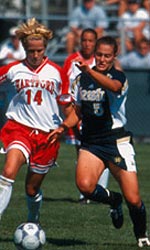 |
| Vanessa Pruzinsky was named a first team Academic All-American as both a sophomore and junior. |
“We still want to be a team that is attractive in the way we play, an attacking team with many players involved,” says Waldrum, who readily concedes that the Irish defense needs to reestablish its toughness.
“If that means we score four and give up three – as opposed to winning 1-0 – I’d still probably take my way 4-3, because I believe in developing the game for the public. And players like the attacking style, instead of just sitting back and defending.”
Waldrum calls Pruzinsky “the most focused and on-task player – in everything she does – that I’ve been around in 20 years of coaching.” A converted forward, the Trumbull, Conn., native has excelled both as an outside and central defender during her Irish career.
“Vanessa is one of the best defenders in the country. Even when she’s not at 100 percent, she is a battler who can fight through it and shine as one of the best players on the field,” says Waldrum of Pruzinsky, who could be slowed as she returns from summer rehabilitation to correct an ankle injury.
“You have a player who can dominate because she has the full package of all-around skills and a great mental approach. She’s so physical, has great closing speed, is tough in the air and cracks a hard shot. But her work ethic and dedication are second to none – and that’s what truly sets her apart.”
Another aspect that sets Pruzinsky apart is her academic accomplishments. The second Notre Dame student-athlete ever named a first team Academic All-American as both a sophomore and junior, Pruzinsky is two semesters shy of becoming just the third chemical engineering major to graduate from Notre Dame with a 4.0 cumulative GPA – dating back to 1908 (the others graduated in 1964 and ’73). She also remains the only female student ever to earn an A grade in Notre Dame’s introduction to chemical engineering course (women first were admitted in 1975).
Waldrum sees the team’s only other senior as a key factor to a successful 2002 season.
“Ashley Dryer is such an underrated player but she really is the key to everything. She makes us go and has to be healthy and on the field,” says Waldrum. “She joined the program as a recruited walk-on but we couldn’t keep her off the field. Now, I’d challenge you to find a better defensive midfielder in the country.”
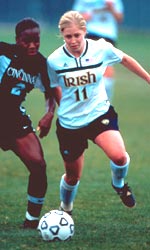 |
| Ashley Dryer is a vital part of the Notre Dame midfield. |
Dryer’s value was magnified in the 2000 NCAA semifinals, when the Irish shifted to a 4-2-4 formation due to the absence of the injured Salt Lake City native. North Carolina head coach Anson Dorrance acknowledged the importance of Dryer’s absence in his postgame comments and she showed more primetime value in the drive to the 2001 BIG EAST title, marking BIG EAST midfielder of the year Sarah Rahko out of the game in the semifinal win over Boston College before neutralizing West Virginia playmaker Lisa Stoia in the title game.
Despite their quiet and subdued personalities, Notre Dame’s seniors – who join Warner as the team’s tri-captains – will be vital leaders in 2002.
“Ashley and Vanessa have started to come out of their shell and their comments always make a very positive impact,” says Waldrum.
“It’s like those old E.F. Hutton commercials when he speaks and everyone gets quiet. It’s an eye-opener for them that their comments could have that type of impact, but we need them to continue developing that vocal leadership. It’s a challenge they are eager to meet.”
Notre Dame’s trio of junior forwards is poised to take its place among the nation’s elite group of attacking players, each bringing her distinct style to the field. Warner’s high-energy, speed-driven approach combined with Guertin’s poised play and steady finishing to earn them the nickname of “Fire and Ice” when they broke onto the scene as freshmen in 2000. One year later, they were joined by their rough-and-tumble classmate Tancredi (she missed 2000 due to injury), whose classic combination of power and speed possibly could earn her the moniker of “Earthquake.”
“All three of those players had strong springs and became more comfortable playing together,” says Waldrum. “When you have highly-skilled players who can sense and anticipate the actions of their teammates, that can be very hard to counteract.
“The great thing about those three is their diverse skills. They aren’t remotely carbon copies of one another and can be a deadly combination when clicking on all cylinders. They do a great job interchanging spots on the field and that really keeps defenses off-balance.
“I would hate to be playing against us, trying to figure out how to defend and where to focus your defensive priority. It’s a tall order to deal with all three of them.”
Guertin (Grapevine, Texas) has evolved into both a clutch and consistent scorer, heading into 2002 with a 10-game goalscoring streak that ranks third in Division I women’s soccer history. Most noted for her highly-technical play and unwavering composure around the goal, Guertin’s pinpoint corner kicks always are a threat to find the back of the net. Her team-leading 36 points in 2001 (15G-6A) included six gamewinning goals, but her only postseason honor was BIG EAST Tournament MVP.
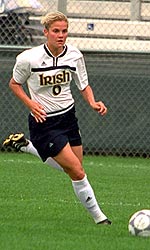 |
| Amanda Guertin knocked in six game-winning goals in the 2001 season. |
” ‘Gerty’ has not received her just due in terms of honors, and maybe that’s because her skills are so subtle and steady,” says Waldrum. “You’re talking about a very clever player who plays so well with her back to the goal. But she also has a very accurate shot and that poise is something you never take for granted. You have to see her on a regular basis to fully appreciate her – and there’s no greater appreciation for a forward than the ability to consistently create and finish chances.”
The speedy Warner (Albuquerque, N.M.) will be looking to return to her freshman-year form, when she totaled seven goals and four assists in the first 10 games before suffering a knee injury that limited her the rest of the way (she totaled 10 goals as a rookie, adding eight more in 2001).
“Amy’s fitness level was at a very high level this summer and she appears ready to have a great junior season,” says Waldrum. “We really will need Amy to create a lot of chances with her pace and of course to finish her chances. She can be a very dangerous threat this season”
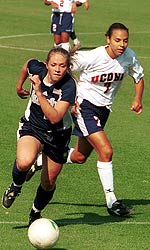 |
| Amy Warner finished the 2001 season with eight goals for the Irish. |
Tancredi (Ancaster, Ontario) – known for her quick wit and free spirit – compensated for missing all of 2000 (due to a knee injury) by making a lasting impression on Notre Dame’s 2001 opponents. A physical 5-9 presence and one of the team’s best threats as a target player, Tancredi’s first season yielded four goals and four assists in 16 games played (10 starts) – including gamewinning assists versus Nebraska and West Virginia in the BIG EAST title game.
“Melissa is one of those special players who can hurt the opposition in so many ways. If she can stay healthy and be a consistent finisher, we could have a special season from that group of frontrunners,” says Waldrum.
Two freshmen from the west coast – Katie Thorlakson (Langley, B.C.) and Maggie Manning (Lake Oswego, Ore.) – could shuttle in as fresh frontrunners to apply pressure in the attacking third.
Manning was the Gatorade player of the year for Oregon, with 90 goals in three seasons at Jesuit High School. A skillful playmaker with solid technical ability, she has offensive traits similar to Gonzalez during her days as an Irish forward.
Thorlakson – who played alongside Chapman on Canada’s under-19 national team – also is a strong candidate as an offensive midfielder, due to her playmaking and feisty nature.
“Katie may only be 5-3 but she is a tough player who is hard to knock off the ball due to her powerful body,” says Waldrum. “She also had the distribution skills and vision to make that rare play that can spring a teammate off the first pass. Katie can be a big difference maker and will add a lot of energy to our attack.”
Boland (Hudson, Ohio) also has equal possibilities at forward and midfield (and even defense). The 5-9 sophomore experienced the highlight and lowlight of her rookie season in the same game, scoring in the seventh minute of the 2-1 win over Penn State before suffering a leg injury in the final seconds (she played just nine of the final 20 games, with five starts, a second goal and two assists).
“We thought last season that Mary might be our best player and she probably was the best player on the field in that Penn State game,” recalls Waldrum.
“Mary has played all the positions at a high level. She has the attacking mentality to push one of those juniors for starting time. She also could be very effective in the high midfield spot, has played some central defense and could make a great outside back because of her ball skills and abilities both 1-vs.-1 and attacking down the flanks. A strong season from Mary really could make a deep impact on this season.”
Freshman Holly Law (Pittsburgh, Pa.) joins fellow recruited walk-on Manning as the only freshmen who are slotted solely at forward, alongside the veterans. Law earned NSCAA All-America honors while totaling 93 career goals (32 as a senior) at Upper St. Clair High School.
With Dryer ready to shoulder the Waldrum-imposed title of “key to the midfield,” Scheller’s role – in terms of positioning – could be just as important. The crafty playmaker had a solid sophomore season in 2001 (4G-7A, including the gamewinning goal in the BIG EAST title game), after inheriting the offensive midfielder role held the previous season by 2000 national player of the year Anne Makinen. But with more options suddenly available for that spot in 2002, the native of Kutztown, Pa., may be a more natural fit playing alongside Dryer in the more defensive midfielder roles.
“We’re very confident in Randi’s ability to play either position. She could set the play for us better in that deeper position, although she has to continue improving her defensive consistency,” says Waldrum of Scheller, whose eagerness for her junior season is fueled by missing most of the spring due to shin-splints surgery.
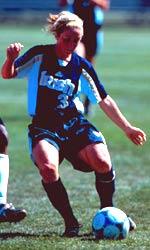 |
| According to Waldrum, midfielder Randi Scheller is a pure soccer player with technical ability. |
“Randi made a big step last year but we think she can make a bigger one this year, to the point of getting some national recognition and getting into the national team pool. She is such a pure soccer player with great technical ability and field vision – and she is extremely fit and ready. I really think you’ll see a lot of great leadership and playmaking from Randi.”
The recent spring exhibition games versus Mexico have provided some unique opportunities for Carpenter. The 5-1 fireplug started as an outside back in the 2001 Mexico game before filling the offensive midfielder last spring, scoring the first Irish goal in that 3-2 win.
“Kim really made a case last spring for being in contention for a starting spot this fall,” says Waldrum. “She started to make her way through our offensive scheme, finding the seams and getting open runs. She was creating offense instead of just supporting the forwards and that can add an important layer to the offense.
“It’s a battle in that part of the field but Kim actually rates out as the strongest player on our team, in relation to her size. She may be of small stature but can hold her own and is smarter in not getting caught in those confrontation battles.”
As the start of fall practice approached, the Irish had another strong option in the midfield. Schefter (Yakima, Wash.) had made big strides as a member of the U.S. under-19 program and was a proven winner on the soccer field and basketball court, winning a state title alongside current Irish basketball player Teresa Borton at West Valley High School.
“Annie’s talents as a point guard are very comparable to her soccer strengths: great field vision, passing skills and ball control,” says Waldrum. “You sense she’s going to make a big impact from the start. But I also can tell you that she is motivated to come back from the injury and truly make the most of her time on the field. She’s a special player but – as has happened several times in the past few years – this just provides others with an opportunity to step up to the challenge.”
Sophomore Sarah Halpenny (Glendale, Calif.) – a transfer from UC-Irvine – could be a surprise performer in the midfield or at outside back. Freshmen Michelle Daley (Redondo, Calif.) and Jenny Walz (Bloomington, Ill.) provide further depth to the midfield, with Walz impressing the Irish coaches at the Notre Dame soccer camp due to her ball skills and high work rate.
Notre Dame’s lineup is most unsettled in the back, where the Irish must replace three of five starters (including two-year starter Wagner in the goal). Combine those departures with national-team commitments for two defenders (Chapman and Gunnarsdottir, a.k.a. “Gunna”), Pruzinsky’s uncertain early status and Schefter’s season-ending injury – and you have the recipe for great uncertainty on the back.
“All we can say for sure is that we intend to start Chapman again at right back, but she will be arriving late after the Under-19 World Cup,” says Waldrum, whose 13 returning players have combined to make just 95 career starts in the defensive third – with Pruzinsky owning 71 of those.
“You would like to keep Vanessa at central back but she may have to go outside, where she played as a freshman,” says Waldrum. “Gunna and Cat Sigler are players who could start at either position while there are three others who traditionally are thought of as midfielders – Boland, Tate and Carpenter – who could emerge at left back.” Even Tancredi has been considered as a central-back option, with the potential to combine with Pruzinsky as a bruising tandem.
“There will be some experimentation but there are very challenging games early in the season,” adds Waldrum. “These players have the talent to get it done but we will need that chemistry and consistency clicking pretty early.”
Chapman (Ajax, Ontario) already is being touted as a potential breakthrough player on the college and international scene, with her ability to excel at multiple positions simply adding to her allure. A member of Soccer America’s national All-Freshman team and a first team all-BIG EAST pick in 2001, Chapman adjusted to the new experience of playing defense by helping the Irish post an 0.82 goals-against average. And she was more than willing to join in the attack, with slicing runs down the right flank and an offensive total that included three goals and two assists (some coming as a forward).
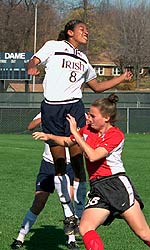 |
| Candace Chapman was a first team all-BIG EAST pick in 2001. |
“People at the highest levels are very impressed with Candace, not so much in her ability right now but also in the big strides that she continues to make. Essentially, she is a player with tremendous upside and we need that type of leadership and expanded role from her,” explains Waldrum.
“Candace always has been a player with tremendous moves and a great scoring punch, but you have really seen her make strides in her defensive anticipation and marking skills during the past year. She should be a fun player to watch this year, possibly one of the most exciting players in the college game.”
Chapman missed just one start in 2001 but that game ended up being the season finale, as illness sidelined the right back for most of the NCAA second-round game versus Cincinnati. Gunnarsdottir (Seltjarnames, Iceland) – who previously had played central back – suddenly was called upon to start on the outside (her fourth start and 17th game played), a call she could be more prepared for in 2002.
“It took a while for Gunna to learn our defensive zone system, considering that she came in with a knee injury that slowed her from the start. But she had a great spring and has learned the system – she’s a very intelligent player who knows the game as well as anybody on this team,” says Waldrum.
“You may not think of her as physically imposing, but Gunna always grades out as our best 1-vs.-1 defender. She’s very good at distributing and could be one of our most important players.”
Sigler (Windsor, Calif.) joins the Notre Dame program in similar fashion to Warner’s arrival two years ago, as a promising player who was slightly off the radar screen due to minimal Olympic Development and national team experience (because of commitments to other sports and school activities).
“We are very eager to plug ‘Cat’ into our system and see how she does,” says Waldrum of Sigler, who had a conversation about her college choice with legendary Notre Dame quarterback Joe Montana (his daughters also attend Ursuline High School).
“She is a fast, athletic and fairly tall player who simply knows how to be a great defender. She’s very composed, reads the action well, can track people down and is very good in the air. She’s also very adept at moving forward and is a scoring threat on set pieces. So, again we come back to it, this is a player you could see at that central spot or left back – it appears she has the skills needed for both.”
Tate (Weymouth, Mass.) made a good impression at the 2001 walk-on tryouts, earning a roster spot before appearing in nine games as a midfielder and forward. She also got a look at outside back during the 2002 spring exhibition versus Mexico and could be more of a candidate in the defense after Schefter’s unfortunate injury.
“Molly’s the type of player that you love to coach because she is so eager to learn and values her time on the field. She has classic flank-player qualities and will need to develop her defensive skills to see time at outside back – but she has a chance to make an impact.”
Sophomore Kate Tulisiak (Medina, Ohio) – sister of former Irish forward Kelly Tulisiak – could see more time at outside back, as she continues to gain experience at the college level. A driven competitor with good physical skills and athleticism, Tulisiak will be looking to improve her technical skills after seeing some qualities minutes in 2001, when she appeared in seven games.
Three freshmen round out the defense, including in-state products Amber McMillin (West Harrison) and Anne Wieber (South Bend), and Miranda Ford (Portola Valley, Calif.), one of eight west-coast players on the roster. McMillin, who made an impression at the Notre Dame soccer camp, will be looking to improve her technical skills while building on her athleticism and competitiveness.
The 5-9 Kent (Santa Margarita, Calif.) – who totaled 146 minutes of playing time as Wagner’s backup in 2000 and ’01 – showed signs of progress last spring, logging extensive minutes for the first time in her college career.
“We expect Lauren to step up and compete for the starting spot, because the talent is there,” says Waldrum. “Lauren has good hands and is very good in her reactions, particularly on breakaways. Naturally there are areas she needs to work on – but the key thing will be consistency. That’s something that you look for at any position.”
Bohn was rated among the nation’s top ‘keepers, after a stellar career at Brookside (Conn.) High School, in addition to starring with her Yankee Rage club team and ODP regional squad. The six-foot newcomer set team records for career shutouts (41) and goals-against average (0.68), also totaling 16 career goals as a free-kick specialist.
“Erika has great physical tools and most coaches had her rated among the top three in the country,” says Waldrum. “She is very good with her feet but also is good distributor with her hands, due to her strength and size. Erika has good range and is very strong both on crosses and being aggressive off her line. The challenge will be taking her game to that next level. Some players make that jump quicker than others. But all in all we are looking forward to a healthy competition in the goal. That’s something all teams need to reach their potential.”







